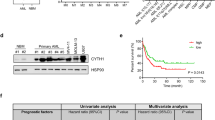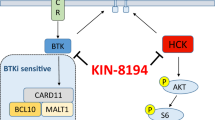Abstract
Multiple myeloma (MM) is incurable, mainly because of cell adhesion-mediated drug resistance (CAM-DR). In this study, we performed functional screening using short hairpin RNA (shRNA) to define the molecule(s) responsible for CAM-DR of MM. Using four bona fide myeloma cell lines (KHM-1B, KMS12-BM, RPMI8226 and U266) and primary myeloma cells, we identified CD29 (β1-integrin), CD44, CD49d (α4-integrin, a subunit of VLA-4), CD54 (intercellular adhesion molecule-1 (ICAM-1)), CD138 (syndecan-1) and CD184 (CXC chemokine receptor-4 (CXCR4)) as major adhesion molecules expressed on MM. shRNA-mediated knockdown of CD49d but not CD44, CD54, CD138 and CD184 significantly reversed CAM-DR of myeloma cells to bortezomib, vincristine, doxorubicin and dexamethasone. Experiments using blocking antibodies yielded almost identical results. Bortezomib was relatively resistant to CAM-DR because of its ability to specifically downregulate CD49d expression. This property was unique to bortezomib and was not observed in other anti-myeloma drugs. Pretreatment with bortezomib was able to ameliorate CAM-DR of myeloma cells to vincristine and dexamethasone. These results suggest that VLA-4 plays a critical role in CAM-DR of MM cells. The combination of bortezomib with conventional anti-myeloma drugs may be effective in overcoming CAM-DR of MM.
This is a preview of subscription content, access via your institution
Access options
Subscribe to this journal
Receive 50 print issues and online access
$259.00 per year
only $5.18 per issue
Buy this article
- Purchase on Springer Link
- Instant access to full article PDF
Prices may be subject to local taxes which are calculated during checkout






Similar content being viewed by others
References
Annunziata CM, Davis RE, Demchenko Y, Bellamy W, Gabrea A, Zhan F et al. (2007). Frequent engagement of the classical and alternative NF-κB pathways by diverse genetic abnormalities in multiple myeloma. Cancer Cell 12: 115–130.
Chauhan D, Uchiyama H, Akbarali Y, Urashima M, Yamamoto K, Libermann TA et al. (1996). Multiple myeloma cell adhesion-induced interleukin-6 expression in bone marrow stromal cells involves activation of NF-κB. Blood 87: 1104–1112.
Cook G, Dumbar M, Franklin IM . (1997). The role of adhesion molecules in multiple myeloma. Acta Haematol 97: 81–89.
Corso A, Ferretti E, Lunghi M, Zappasodi P, Mangiacavalli S, De Amici M et al. (2005). Zoledronic acid down-regulates adhesion molecules of bone marrow stromal cells in multiple myeloma: a possible mechanism for its antitumor effect. Cancer 104: 118–125.
Damiano JS, Cress AE, Hazlehurst LA, Shtil AA, Dalton WS . (1999). Cell adhesion mediated drug resistance (CAM-DR): role of integrins and resistance to apoptosis in human myeloma cell lines. Blood 93: 1658–1667.
Davies AM, Lara Jr PN, Mack PC, Gandara DR . (2007). Incorporating bortezomib into the treatment of lung cancer. Clin Cancer Res 13: 4647s–4651s.
Dolcet X, Llobet D, Pallares J . (2005). NF-κB in development and progression of human cancer. Virchows Arch 446: 475–482.
Drexler HG, Matsuo Y, MacLeod RA . (2003). Persistent use of false myeloma cell lines. Hum Cell 16: 101–105.
Duechler M, Shehata M, Schwarzmeier JD, Hoelbl A, Hilgarth M, Hubmann R . (2005). Induction of apoptosis by proteasome inhibitors in B-CLL cells is associated with downregulation of CD23 and inactivation of Notch2. Leukemia 19: 260–267.
Fisher RI, Bernstein SH, Kahl BS, Djulbegovic B, Robertson MJ, de Vos S et al. (2006). Multicenter phase II study of bortezomib in patients with relapsed or refractory mantle cell lymphoma. J Clin Oncol 24: 4867–4874.
Hazlehurst LA, Damiano JS, Buyuksal I, Pledger WJ, Dalton WS . (2000). Adhesion to fibronectin via β1 integrins regulates p27kip1 levels and contributes to cell adhesion mediated drug resistance (CAM-DR). Oncogene 19: 4319–4327.
Hideshima T, Mitsiades C, Tonon G, Richardson PG, Anderson KC . (2007). Understanding multiple myeloma pathogenesis in the bone marrow to identify new therapeutic targets. Nat Rev Cancer 7: 585–598.
Hideshima T, Richardson P, Chauhan D, Palombella VJ, Elliott PJ, Adams J et al. (2001). The proteasome inhibitor PS-341 inhibits growth, induces apoptosis, and overcomes drug resistance in human multiple myeloma cells. Cancer Res 61: 3071–3076.
Horton TM, Gannavarapu A, Blaney SM, D’Argenio DZ, Plon SE, Berg SL . (2006). Bortezomib interactions with chemotherapy agents in acute leukemia in vitro. Cancer Chemother Pharmacol 58: 13–23.
Keats JJ, Fonseca R, Chesi M, Schop R, Baker A, Chng WJ et al. (2007). Promiscuous mutations activate the noncanonical NF-κB pathway in multiple myeloma. Cancer Cell 12: 131–144.
Kikuchi J, Ozaki H, Nonomura C, Shinohara H, Iguchi S, Nojiri H et al. (2005). Transfection of antisense core 2 β1,6-N-acetylglucosaminyltransferase-1 cDNA suppresses selectin ligand expression and tissue infiltration of B-cell precursor leukemia cells. Leukemia 19: 1934–1940.
Kikuchi J, Shimizu R, Wada T, Ando H, Nakamura M, Ozawa K et al. (2007). E2F-6 suppresses growth-associated apoptosis of human hematopoietic progenitor cells by counteracting proapoptotic activity of E2F-1. Stem Cells 25: 2439–2447.
Kirschner KM, Wagner N, Wagner KD, Wellmann S, Scholz H . (2006). The Wilms tumor suppressor Wt1 promotes cell adhesion through transcriptional activation of the α4 integrin gene. J Biol Chem 281: 31930–31939.
Kyle RA, Gertz MA, Witzig TE, Lust JA, Lacy MQ, Dispenzieri A et al. (2003). Review of 1027 patients with newly diagnosed multiple myeloma. Mayo Clin Proc 78: 21–33.
Landowski TH, Olashaw NE, Agrawal D, Dalton WS . (2003). Cell adhesion-mediated drug resistance (CAM-DR) is associated with activation of NF-κB (RelB/p50) in myeloma cells. Oncogene 22: 2417–2421.
Lin YZ, Yao SY, Veach RA, Torgerson TR, Hawiger J . (1995). Inhibition of nuclear translocation of transcription factor NF-κB by a synthetic peptide containing a cell membrane-permeable motif and nuclear localization sequence. J Biol Chem 270: 14255–14258.
Matsunaga T, Takemoto N, Sato T, Takimoto R, Tanaka I, Fujimi A et al. (2003). Interaction between leukemic-cell VLA-4 and stromal fibronectin is a decisive factor for minimal residual disease of acute myelogenous leukemia. Nat Med 9: 1158–1165.
Michigami T, Shimizu N, Williams PJ, Niewolna M, Dallas SL, Mundy GR et al. (2000). Cell–cell contact between marrow stromal cells and myeloma cells via VCAM-1 and α4β1-integrin enhances production of osteoclast-stimulating activity. Blood 96: 1953–1960.
Mitsiades N, Mitsiades CS, Poulaki V, Chauhan D, Richardson PG, Hideshima T et al. (2002). Apoptotic signaling induced by immunomodulatory thalidomide analogs in human multiple myeloma cells: therapeutic implications. Blood 99: 4525–4530.
Miyakoshi S, Kami M, Yuji K, Matsumura T, Takatoku M, Sasaki M et al. (2006). Severe pulmonary complications in Japanese patients after bortezomib treatment for refractory multiple myeloma. Blood 107: 3492–3494.
Mori T, Kiyono T, Imabayashi H, Takeda Y, Tsuchiya K, Miyoshi S et al. (2005). Combination of hTERT and bmi-1, E6, or E7 induces prolongation of the life span of bone marrow stromal cells from an elderly donor without affecting their neurogenic potential. Mol Cell Biol 25: 5183–5195.
Mori Y, Shimizu N, Dallas M, Niewolna M, Story B, Williams PJ et al. (2004). Anti-α4 integrin antibody suppresses the development of multiple myeloma and associated osteoclastic osteolysis. Blood 104: 2149–2154.
Nefedova Y, Landowski TH, Dalton WS . (2003). Bone marrow stromal-derived soluble factors and direct cell contact contribute to de novo drug resistance of myeloma cells by distinct mechanisms. Leukemia 17: 1175–1182.
Noborio-Hatano K, Kano Y, Akustu M, Kikuchi J, Ueda M, Takatoku M et al. (2007). Effects of bortezomib in combination with conventional drugs against human lymphoid cell lines. Jpn J Clin Hematol 48: 1093a.
Odgerel T, Kikuchi J, Wada T, Shimizu R, Futaki K, Kano Y et al. (2008). The FLT3 inhibitor PKC412 exerts differential cell cycle effects on leukemic cells depending on the presence of FLT3 mutations. Oncogene 27: 3102–3110.
Olson DL, Burkly LC, Leone DR, Dolinski BM, Lobb RR . (2005). Anti-α4 integrin monoclonal antibody inhibits multiple myeloma growth in a murine model. Mol Cancer Ther 4: 91–99.
Pearse RN, Sordillo EM, Yaccoby S, Wong BR, Liau DF, Colman N et al. (2001). Multiple myeloma disrupts the TRANCE/osteoprotegerin cytokine axis to trigger bone destruction and promote tumor progression. Proc Natl Acad Sci USA 98: 11581–11586.
Pfaffl MW . (2001). A new mathematical model for relative quantification in real-time RT–PCR. Nucleic Acid Res 29: e45.
Richardson PG, Barlogie B, Berenson J, Singhal S, Jagannath S, Irwin D et al. (2003). A phase 2 study of bortezomib in relapsed, refractory myeloma. N Engl J Med 348: 2609–2617.
Richardson PG, Sonneveld P, Schuster MW, Irwin D, Stadtmauer EA, Facon T et al. (2005). Assessment of proteasome inhibition for extending remissions (APEX) investigators. Bortezomib or high-dose dexamethasone for relapsed multiple myeloma. N Engl J Med 352: 2487–2498.
Rosen GD, Barks JL, Iademarco MF, Fisher RJ, Dean DC . (1994). An intricate arrangement of binding sites for the Ets family of transcription factors regulates activity of the α4 integrin gene promoter. J Biol Chem 269: 15652–15660.
Schmidmaier R, Morsdorf K, Baumann P, Emmerich B, Meinhardt G . (2006). Evidence for cell adhesion-mediated drug resistance of multiple myeloma cells in vivo. Int J Biol Markers 21: 218–222.
Takatoku M, Noborio-Hatano K, Takahashi S, Kikuchi S, Mori M, Muroi K et al. (2004). Treatment with a proteasome inhibitor, bortezomib, for thalidomide-resistant multiple myeloma. Jpn J Clin Hematol 45: 144–148.
Tatsumi T, Shimazaki C, Goto H, Araki S, Sudo Y, Yamagata N et al. (1996). Expression of adhesion molecules on myeloma cells. Jpn J Cancer Res 87: 837–842.
Yanamandra N, Colaco NM, Parquet NA, Buzzeo RW, Boulware D, Wright G et al. (2006). Tipifarnib and bortezomib are synergistic and overcome cell adhesion-mediated drug resistance in multiple myeloma and acute myeloid leukemia. Clin Cancer Res 12: 591–599.
Zutter MM, Ryan EE, Painter AD . (1997). Binding of phosphorylated Sp1 protein to tandem Sp1 binding sites regulates α2 integrin gene core promoter activity. Blood 90: 678–689.
Acknowledgements
This study was supported in part by grants from the Ministry of Health, Welfare, and Labor of Japan, and Grants-in-Aid for Scientific Research from the Ministry of Education, Science, Sports, and Technology of Japan. KN-H and JK are winners of the Jichi Medical School Young Investigator Award.
Author information
Authors and Affiliations
Corresponding author
Additional information
Supplementary Information accompanies the paper on the Oncogene website (http://www.nature.com/onc)
Rights and permissions
About this article
Cite this article
Hatano, K., Kikuchi, J., Takatoku, M. et al. Bortezomib overcomes cell adhesion-mediated drug resistance through downregulation of VLA-4 expression in multiple myeloma. Oncogene 28, 231–242 (2009). https://doi.org/10.1038/onc.2008.385
Received:
Revised:
Accepted:
Published:
Issue Date:
DOI: https://doi.org/10.1038/onc.2008.385
Keywords
This article is cited by
-
Expression of integrin β-7 is epigenetically enhanced in multiple myeloma subgroups with high-risk cytogenetics
Clinical Epigenetics (2023)
-
Ablation of VLA4 in multiple myeloma cells redirects tumor spread and prolongs survival
Scientific Reports (2022)
-
In vivo quantitative assessment of therapeutic response to bortezomib therapy in disseminated animal models of multiple myeloma with [18F]FDG and [64Cu]Cu-LLP2A PET
EJNMMI Research (2021)
-
Integrins in multiple myeloma
Inflammation and Regeneration (2020)
-
Blockade of VLA4 sensitizes leukemic and myeloma tumor cells to CD3 redirection in the bone marrow microenvironment
Blood Cancer Journal (2020)



